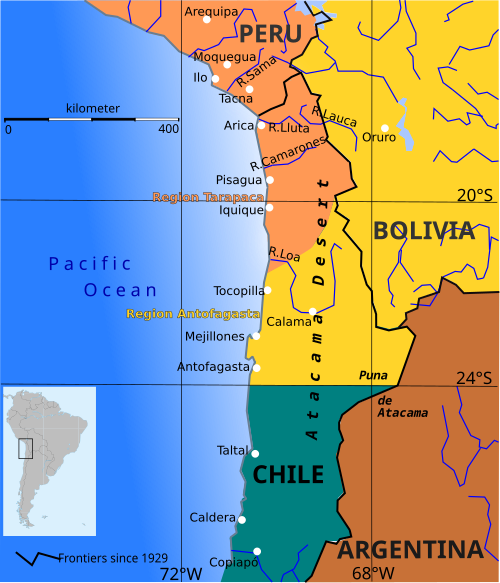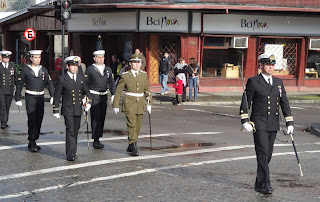 Later, as I expanded my historical knowledge I learned that all of this dates from the War of the Pacific (1879-1883). Prior to the war Chile's northern border ended south of the city of Antofogasta. Equally important, Peru's southern border extended 300 km furhter south along the Pacific. But most importantly, Bolivia had 30
Later, as I expanded my historical knowledge I learned that all of this dates from the War of the Pacific (1879-1883). Prior to the war Chile's northern border ended south of the city of Antofogasta. Equally important, Peru's southern border extended 300 km furhter south along the Pacific. But most importantly, Bolivia had 30 0 km of coastline and access to the Pacific Ocean. Following the war, Chile gained significant territory in the northern mineral rich, desert north. The war's economic impact is keenly felt today in Bolivia. Chilean's however will be quick to point out that the Bolivians enlisted the Peruvians as allies and fired the first shot. Wikipedia does a decent jump on a more complete overview: http://en.wikipedia.org/wiki/War_of_the_Pacific
0 km of coastline and access to the Pacific Ocean. Following the war, Chile gained significant territory in the northern mineral rich, desert north. The war's economic impact is keenly felt today in Bolivia. Chilean's however will be quick to point out that the Bolivians enlisted the Peruvians as allies and fired the first shot. Wikipedia does a decent jump on a more complete overview: http://en.wikipedia.org/wiki/War_of_the_Pacific Today, the war is recognized on May 21st, the day of the Battle of Iquique. In that battle, Cmd. Arturo Prat fought against a stronger Bolivian boat. Although he lost, Chileans were stirred by his heroism, enlistments in the armed forces soared and Prat became a patriotic hero and symbol of Chilean bravery.
Being in a port city we figured we'd go downtown and see the para
 de. When we got to the Plaza de Armas, speeches wer being made and sailors stood on alert in various groups. One of our Wedneday night Englsh students, Jacqueline, had told us that her volunteer fire company would be marching in the parade as well. Not to dis the navy, put we first went looking for our friend among Compania 6. Jacqueline is the second from the right. Down the line from the companies of firefighters, the Carabineros (police force) were lined up, followed by the sailors, a band from the high school equivalent of ROTC and another band of various aged folks of whose affiliation we could never quite figure out.
de. When we got to the Plaza de Armas, speeches wer being made and sailors stood on alert in various groups. One of our Wedneday night Englsh students, Jacqueline, had told us that her volunteer fire company would be marching in the parade as well. Not to dis the navy, put we first went looking for our friend among Compania 6. Jacqueline is the second from the right. Down the line from the companies of firefighters, the Carabineros (police force) were lined up, followed by the sailors, a band from the high school equivalent of ROTC and another band of various aged folks of whose affiliation we could never quite figure out. 
To be honest, there are many things that we only partially figure out. For example, we know that the cueca is the national dance and that everyone how calls themselves Chilean can dance a cueca. I've seen enough school kids being taught the cueca in gym class and had my own humbling experience in a cueca dress.
 That said, don't ask me to explain why, in the midst of a naval and public service celebration, was there a break in the speech making for a cueca. The other part of the celebration that had us scratching our heads was when men in huaso outfits went to the reviewing stand and offered a drink from a horn. Just what is in that bottle in a basket?
That said, don't ask me to explain why, in the midst of a naval and public service celebration, was there a break in the speech making for a cueca. The other part of the celebration that had us scratching our heads was when men in huaso outfits went to the reviewing stand and offered a drink from a horn. Just what is in that bottle in a basket?  And what makes the bald guy, in the 3rd row no less, so special that he gets a drink? We were puzzled so we decided to stroll about and see what the rest of the huasos on horseback were doing. (Huasos are Chilean gentlemen cowboys. There outfits are mostly based on clothes worn on the farms in the central region of Chile. Around Ch
And what makes the bald guy, in the 3rd row no less, so special that he gets a drink? We were puzzled so we decided to stroll about and see what the rest of the huasos on horseback were doing. (Huasos are Chilean gentlemen cowboys. There outfits are mostly based on clothes worn on the farms in the central region of Chile. Around Ch iloe, if you can afford a horse and have the time to train the horse in the complicated sport of rodeo, you are of the 'gentlemen' class.) Among the dozen or so huasos of the Castro folklore society I recognized one of my 12th grade students looking muy guapo on his horse. Eventually the speeches ended and it was time for the parade. We felt like locals in the know when we saw the second in command of the Castro naval base march the officers and the sailors down the street.
iloe, if you can afford a horse and have the time to train the horse in the complicated sport of rodeo, you are of the 'gentlemen' class.) Among the dozen or so huasos of the Castro folklore society I recognized one of my 12th grade students looking muy guapo on his horse. Eventually the speeches ended and it was time for the parade. We felt like locals in the know when we saw the second in command of the Castro naval base march the officers and the sailors down the street.  The Captain is also the father of two girls in 3rd grade and kinder at Carpe Diem. We've enjoyed a few rides to and from school with the Captain or his wife as they picked up or dropped their daughters off at Carpe Diem. Both have travelled to the US, he on the Chilean Navy's training tall ship and she when she was a stewardess for LAN. Before he had to march too seriously, the Captain gave a smile and a nod.
The Captain is also the father of two girls in 3rd grade and kinder at Carpe Diem. We've enjoyed a few rides to and from school with the Captain or his wife as they picked up or dropped their daughters off at Carpe Diem. Both have travelled to the US, he on the Chilean Navy's training tall ship and she when she was a stewardess for LAN. Before he had to march too seriously, the Captain gave a smile and a nod.Other folks were a little freer to give us an ebulent greeting. The parade finished right around lunchtime so we made haste to the empanada stand. The empanada stand is Berto's
 favorite spot in Castro and the empanada ladies always greet Berto like he was their favorite customer. I fear the milcao lady on the end has heard the rumor that the gringos think milcaos are lead colored grease bombs. She is not as chatty. After ordering meat empanadas and a seafood (mostly clam) empanada, the ladies invited Berto into the stand for a group photo.
favorite spot in Castro and the empanada ladies always greet Berto like he was their favorite customer. I fear the milcao lady on the end has heard the rumor that the gringos think milcaos are lead colored grease bombs. She is not as chatty. After ordering meat empanadas and a seafood (mostly clam) empanada, the ladies invited Berto into the stand for a group photo.This being Chiloe, the outing was puncuated by a short rain shower. We took our empanadas to eat under the overhang in front of the municipal offices. When the rain cleared, Mike, Gabi and Berto took the bus home for an afternoon nap. I walked the 4 km home enjoying the spell of sunshine. I was not the only one enjoying the afternoon.
 Gulls sunned themselves in the Gamboa river in front of palafitos. And a horse was in the field across from our house.
Gulls sunned themselves in the Gamboa river in front of palafitos. And a horse was in the field across from our house.

Hello Lisa and Mike,
ReplyDeleteI have just spent some time reading through some of your posts on your blog and I wanted to say 'thank you!'. I am in Australia and have a teenager who will be leaving on a semester's exchange to Castro shortly so it has been great to get some insights from the prespective of 'gringos'. All the for the tail-end of your 'year'. Kind regards, Herta